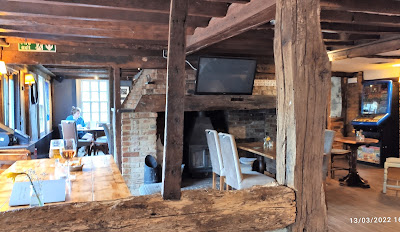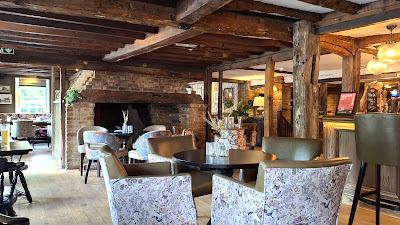This post is written with Retired Martin in mind, after he commented on one of my recent posts. He wrote that he was looking forward to reading about the Cardinal's Error, which might be the only Tonbridge pub he hadn’t been in. For those who don’t know the town, and I’m assuming that probably means more than a few of you, the Cardinal’s is an attractive, old tile-hung pub which dates back to the 16th century. Surrounded by a post-war housing development, the pub seems a little incongruous, but it’s worth remembering that following World War II, the country faced an acute housing shortage. The solution was the construction of a large number of housing estates, under the control of the local authority, and then rented out at an affordable rate to local people.
Known as “council housing” at the time, and “social housing” today, the planners of the estate just to the north of Somerhill House, had the foresight to provide occupants of the new dwellings with their own public house, in conjunction with local brewer, Frederick Lenny & Sons Ltd. Leney’s, who brewed at the Phoenix Brewery in Wateringbury, acquired the two farmhouse cottages in 1946, with the intention of converting them into a public house. They transferred the liquor license from the old White Hart beer house on Tonbridge High Street, and the pub opened for business a few years later. The pub was named the "Cardinal's Error” with the figure of Cardinal Thomas Wolsey featuring on the sign. Wolsey had suppressed Tonbridge Priory (plundered the place for its wealth), with the blessing of his master, Henry VIII, but much against the wishes of the townsfolk. By way of reparation, the Cardinal promised to build a grammar school in place of the priory, but unfortunately for him, and the good people of Tonbridge, he fell from favour before he could carry out his promise. His “error” of course, was putting his trust in the bloodthirsty tyrant, that was Henry VIII.It's interesting to note that Leney’s had been a subsidiary of Whitbread & Co Ltd since 1927, but in 1961 sold their tied estate to Fremlin’s Ltd of Maidstone. That situation didn’t last long, because six years later, Fremlin’s was purchased by Whitbread & Co Ltd, returning the Cardinal’s Error to its original brewery. In 2002 Whitbread sold its pub estate, to Enterprise Inns, and today the pub is run by Pendry’s Pubs Ltd. That’s enough history, apart from saying that at one time, I was a regular visitor to what was then, a two-bar local, on the edge of town. That was when I first started working in Tonbridge, which was some five years before I moved to the town. The Cardinal’s was a good place for a lunchtime drink, back in the days when enjoying a couple of pints at lunchtime was perfectly acceptable. The pub served a particularly well-kept pint of Fremlin’s Bitter, and you could also get a decent sausage sandwich there, as well. The Cardinals had two bars, back then, which were quite distinct from one another, but this arrangement worked. Things changed a decade or so later, and whilst I can’t remember exactly when the changes took place, they were to the detriment of both bars. The cosy atmosphere of the former saloon bar vanished, as did the more down-to-earth feel of the public bar.
Today, the Cardinal’s remains divided internally into two distinct drinking areas by a massive brick chimney, with open fireplaces either side, although the addition of a games area, for pool, darts, plus TV sports, has now left the former public bar as the quietest part of the pub. Over the years the Cardinal’s has become much more of a local’s pub than it had been previously, which is probably due to the demise of the lunchtime, office, drinking crowd, but the main thing is it is still trading. The Cardinal’s had been unknown territory since before the pandemic, and whilst I’d contemplated calling in there for a while, when push came to the shove, I kept backing away.
This situation continued for the best part of a year, and whilst I’m not usually a procrastinator, I was in this instance. I’m not quite sure where this reluctance stemmed from, although it may have been because I perceived the pub as being a bit rough. It might well have been, back in the day, but following the piecemeal sale of a large chunk of the former council estate, under Thatcher’s “right to buy scheme,” the area has undergone a transformation, so that argument no longer holds true.
So, last Thursday lunchtime, I bit the bullet and took a wander along to the pub. It was just over 5 minutes’ walk, so nice and convenient then, but would it deliver on the beer front, plus the “somewhere to go for a nice quiet drink” front as well. I’m pleased to report that the pub ticked both those boxes, as well as wiping away all my negative expectations. I would guess there were a half-dozen or so customers in the pub, some sitting at the bar, some playing pool, plus one or two nicotine addicts standing outside. They were all male, with the landlady the only member of the opposite sex. Quite a few of the blokes seemed a similar age to me, which was a good sign, as far as I am concerned.
I spotted pump clip for St Austell Tribute, affixed to one of the beer engine handles, and whilst I am quite fond of this beer, I asked the landlady whether the pub also stocked Harvey’s. They didn’t, apparently as it’s an expensive beer when bought wholesale, I already knew this, plus I was told, it didn’t keep particularly well. She also mentioned that there wasn’t the turnover for the pub to stock two cask ales. It was then that the penny dripped, because, as mentioned earlier, the Cardinal’s is owned by Pendry’s Pubs Ltd, a small pub-co that also includes the Chequers in Tonbridge High Street, as part of its estate.
The beer was fine, so seeing as I was a nice day, I tool my pint outside, and sat under the semi-covered pergola area, adjacent to the games area and over looking the pub garden. The latter seems to count include a marquee as a semi-permanent fixture, so possibly the pub caters for weddings? At other times, the food offering is confined to hand prepared, stone- baked sourdough pizzas plus bar snack sides, and these seem restricted to Saturday and Sunday afternoons.
All in all, I was impressed with what I found, and I shall definitely be returning. The thought of a nice quiet pub where I can sit and read a book, or engage others in conversation, should I wish, appeal to me. The fact that this particular pub is just a 5-minute stroll away, appeals to me even more, so in the words of Arnold Schwarzenegger, “I’ll be back!”





































